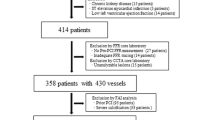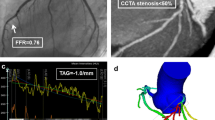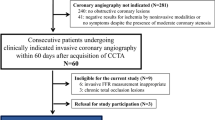Abstract
The aim of the present study was to examine the association of myocardial mass verified by computed tomography (CT) and invasive fractional flow reserve (FFR)—verified myocardial ischemia, or subsequent therapeutic strategy for the targeted vessels after FFR examination. We examined 333 vessels with intermediate stenoses in 297 patients (mean age 69.0 ± 9.5, 228 men) undergoing both coronary CT angiography and invasive FFR, and reviewed the therapeutic strategy after FFR. Of 333 vessels, FFR ≤ 0.80 was documented in 130 (39.0%). Myocardial volume supplied by the target vessel (MVT) was larger in those with FFR-verified ischemia than those without (53.4 ± 19.5 vs. 42.9 ± 22.2 cm3, P < 0.001). Addition of MVT to a model including patient characteristics (age, gender), visual assessment (≥ 70% stenosis, high-risk appearance), and quantitative CT vessel parameters [minimal lumen area (MLA), plaque burden at MLA, percent aggregate plaque volume] improved C-index (from 0.745 to 0.778, P = 0.020). Furthermore, of 130 vessels with FFR ≤ 0.80, myocardial volume exposed to ischemia (MVI) was larger in the vessels with early revascularization after FFR examination than those without (37.2 ± 20.0 vs. 26.8 ± 15.0 cm3, P = 0.003), and was independently associated with early revascularization [OR = 1.03, 95% confidence interval (1.02–1.11), P < 0.001]. Using an on-site CT workstation, MVT identified coronary arteries with FFR-verified ischemia easily and non-invasively, and MVI was associated with subsequent therapeutic strategy after FFR examinations.




Similar content being viewed by others
References
Miller JM, Rochitte CE, Dewey M, Arbab-Zadeh A, Niinuma H, Gottlieb I, Paul N, Clouse ME, Shapiro EP, Hoe J, Lardo AC, Bush DE, Roos A, Cox C, Brinker J, Lima JAC (2008) Diagnostic performance of coronary angiography by 64-row CT. N Engl J Med 359:2324–2336
Motoyama S, Kondo T, Sarai M, Sugiura A, Harigaya H, Sato T, Inoue K, Okumura M, Ishii J, Anno H, Virmani R, Ozaki Y, Hishida H, Narula J (2007) Multislice computed tomographic characteristics of coronary lesions in acute coronary syndromes. J Am Coll Cardiol 50:319–326
Xaplanteris P, Fournier S, Pijls NHJ, Fearon WF, Barbato E, Tonino PAL, Engstrøm T, Kääb S, Dambrink JH, Rioufol G, Toth GG, Piroth Z, Witt N, Fröbert O, Kala P, Linke A, Jagic N, Mates M, Mavromatis K, Samady H, Irimpen A, Oldroyd K, Campo G, Rothenbühler M, Jüni P, Bruyne BD, FAME 2 Investigators (2018) Five-year outcomes with PCI guided by fractional flow reserve. N Engl J Med 379:250–259
Knuuti J, Wijns W, Saraste A, Capodanno D, Barbato E, Brentano CF, Prescott E, Storey RF, Deaton C, Cuisset T, Agewall S, Dickstein K, Edvardsen T, Escaned J, Gersh BJ, Svitil P, Gilard M, Hasdai D, Hatala R, Mahfoud F, Masip J, Muneretto C, Valgimigli M, Achenbach S, Bax JJ, ESC Scientific Document Group (2020) 2019 ESC Guidelines for the diagnosis and management of chronic coronary syndromes. Eur Heart J 41:407–477
Nakazato R, Shalev A, Doh JH, Koo BK, Gransar H, Gomez MJ, Leipsic J, Park HB, Berman DS, Min JK (2013) Aggregate plaque volume by coronary computed tomography angiography is superior and incremental to luminal narrowing for diagnosis of ischemic lesions of intermediate stenosis severity. J Am Coll Cardiol 62:460–467
Park HB, Heo R, ÓHartaigh B, Cho I, Gransar H, Nakazato R, Leipsic J, Mancini GBJ, Koo BK, Otake H, Budoff MJ, Berman DS, Erglis A, Chang HHJ, Min JK (2015) Atherosclerotic plaque characteristics by CT angiography identify coronary lesions that cause ischemia. JACC Cardiovasc Imaging 8:1–10
Gaur S, Øvrehus KA, Dey D, Leipsic J, Bøtker HE, Jensen JM, Narula J, Ahmadi A, Achenbach S, Ko BS, Christiansen EH, Kaltoft AK, Berman DS, Bezerra H, Lassen JF, Nørgaard BL (2016) Coronary plaque quantification and fractional flow reserve by coronary computed tomography angiography identify ischaemia-causing lesions. Eur Heart J 37:1220–1227
Zhang JM, Zhong L, Luo T, Lomarda AM, Huo Y, Yap J, Lim ST, Tan RS, Wong ASL, Wei J, Tan C, Yeo KK, Fam JM, Keng FYJ, Wan M, Su B, Zhao X, Allen JC, Kassab GS, Siang T, Chua J, Tan SY (2016) Simplified models of non-invasive fractional flow reserve based on CT images. PLoS ONE 11(5):e0153070
Zhang JM, Shuang D, Baskaran L, Wu W, Teo SK, Huang W, Gobeawan L, Allen JC, Tan RS, Su X, Ismail NB, Wan M, Su B, Zou H, Low R, Zhao X, Chi Y, Zhou J, Su Y, Lomarda AM, Chin CY, Fam JM, Keng FYJ, Wong ASL, Tan JYC, Yeo KK, Wong FEH, Chin CT, Ho KW, Yap J, Kassab GS, Chua T, Koh TH, Tan SY, Lim ST, Zhong L (2018) Advanced analyses of computed tomography coronary angiography can help discriminate ischemic lesions. Int J Cardiol 267:208–214
Zhang JM, Chandola G, Tan RS, Chai P, Teo LLS, Low R, Allen JC, Huang W, Fam JM, Chin CY, Wong ASL, Low AF, Kassab GS, Chua T, Tan SY, Lim ST, Zhong L (2020) Quantification of effects of mean blood pressure and left ventricular mass on noninvasive fast fractional flow reserve. Am J Physiol Heart Circ Physiol 319:H360–H369
Pijls NH, Tanaka N, Fearon WF (2013) Functional assessment of coronary stenoses: can we live without it? Eur Heart J 34:1335–1344
Yang DH, Kang SJ, Koo HJ, Kweon J, Kang JW, Lim TH, Jung J, Kim N, Lee JG, Han S, Ahn JM, Park DW, Lee SW, Lee CW, Park SW, Park SJ, Mintz GS, Kim YH (2019) Incremental value of subtended myocardial mass for identifying FFR-verified ischemia using quantitative CT angiography. JACC Cardiovasc Imaging 12:707–717
Kim HY, Lim HS, Doh JH, Nam CW, Shin ES, Koo BK, Yoon MH, Tahk SJ, Kang DK, Song YB, Hahn JY, Choi SH, Gwon HC, Lee SH, Kim EK, Kim SM, Choe Y, Choi JH (2016) Physiological severity of coronary artery stenosis depends on the amount of myocardial mass subtended by the coronary artery. JACC Cardiovasc Interv 9:1548–1560
Motoyama S, Sarai M, Harigaya H, Anno H, Inoue K, Hara T, Naruse H, Ishii J, Hishida H, Wong ND, Virmani R, Kondo T, Ozaki Y, Narula J (2009) Computed tomographic angiography characteristics of atherosclerotic plaques subsequently resulting in acute coronary syndrome. J Am Coll Cardiol 54:49–57
Motoyama S, Ito H, Sarai M, Kondo T, Kawai H, Nagahara Y, Harigaya H, Kan S, Anno H, Takahashi H, Naruse H, Ishii J, Hecht H, Shaw LJ, Ozaki Y, Narula J (2015) Plaque characterization by coronary computed tomography angiography and the likelihood of acute coronary events in mid-term follow-up. J Am Coll Cardiol 66:337–346
Kawai H, Motoyama S, Sarai M, Ito H, Takahashi H, Harigaya H, Kan S, Ishii J, Anno H, Murohara T, Ozaki Y (2014) Adding coronary computed tomography angiography to invasive coronary angiography improves prediction of cardiac events. Circ J 78:2735–2740
Leipsic J, Abbara S, Achenbach S, Cury R, Earls JP, Mancini GJ, Nieman K, Pontone G, Raff GL (2014) SCCT guidelines for the interpretation and reporting of coronary CT angiography: a report of the Society of Cardiovascular Computed Tomography Guidelines Committee. J Cardiovasc Comput Tomogr 8:342–358
DeLong ER, DeLong DM, Clarke-Pearson DL (1988) Comparing the areas under two or more correlated receiver operating characteristic curves: a nonparametric approach. Biometrics 44:837–845
Pencina MJ, D’Agostino RB Sr, D’Agostino RB Jr, Vasan RS (2008) Evaluating the added predictive ability of a new marker: from area under the ROC curve to reclassification and beyond. Stat Med 27:157–172 (discussion 207-212)
van Velzen JE, Schuijf JD, de Graaf FR, Boersma E, Pundziute G, Spanó F, Boogers MJ, Schalij MJ, Kroft LJ, Roos A, Jukema JW, Wall EE, Bax JJ (2011) Diagnostic performance of non-invasive multidetector computed tomography coronary angiography to detect coronary artery disease using different endpoints: detection of significant stenosis vs. detection of atherosclerosis. Eur Heart J 32:637–645
Boden WE, O’Rourke RA, Teo KK, Hartigan PM, Maron DJ, Kostuk WJ, Knudtson M, Dada M, Casperson P, Harris CL, Chaitman BR, Shaw L, Gosselin G, Nawaz S, Title LM, Gau G, Blaustein AS, Booth DC, Bates ER, Spertus JA, Berman DS, Mancini GBJ, Weintraub WS, COURAGE Trial Research Group (2007) Optimal medical therapy with or without PCI for stable coronary disease. N Engl J Med 356:1503–1516
Shaw LJ, Berman DS, Maron DJ, Mancini GB, Hayes SW, Hartigan PM, Weintraub WS, O’Rourke RA, Dada M, Spertus JA, Chaitman BR, Friedman J, Slomka P, Heller GV, Germano G, Gosselin G, Berger P, Kostuk WJ, Schwartz RG, Knudtson M, Veledar E, Bates ER, McCallister B, Teo KK, Boden WE, Investigators COURAGE (2008) Optimal medical therapy with or without percutaneous coronary intervention to reduce ischemic burden: results from the Clinical Outcomes Utilizing Revascularization and Aggressive Drug Evaluation (COURAGE) trial nuclear substudy. Circulation 117:1283–1291
Maron DJ, Hochman JS, Reynolds HR, Bangalore S, O’Brien SM, Boden WE, Chaitman BR, Senior R, Sendón JL, Alexander KP, Lopes RD, Shaw LJ, Berger JS, Newman JD, Sidhu MS, Goodman SG, Ruzyllo W, Gosselin G, Maggioni AP, White HD, Bhargava B, Min JK, Mancini GBJ, Berman DS, Picard MH, Kwong RY, Ali ZA, Mark DB, Spertus JA, Krishnan MN, Elghamaz A, Moorthy N, Hueb WA, Demkow M, Mavromatis K, Bockeria O, Peteiro J, Miller TD, Szwed H, Doerr R, Keltai M, Selvanayagam JB, Steg PG, Held C, Kohsaka S, Mavromichalis S, Kirby R, Jeffries NO, Harrell FE Jr, Rockhold FW, Broderick S, Ferguson TB Jr, Williams DO, Harrington RA, Stone GW, Rosenberg Y, ISCHEMIA Research Group (2020) Initial invasive or conservative strategy for stable coronary disease. N Engl J Med 382:1395–1407
Hachamovitch R, Hayes SW, Friedman JD, Cohen I, Berman DS (2003) Comparison of the short-term survival benefit associated with revascularization compared with medical therapy in patients with no prior coronary artery disease undergoing stress myocardial perfusion single photon emission computed tomography. Circulation 107:2900–2907
Author information
Authors and Affiliations
Corresponding author
Ethics declarations
Conflict of interest
None.
Additional information
Publisher's Note
Springer Nature remains neutral with regard to jurisdictional claims in published maps and institutional affiliations.
Rights and permissions
About this article
Cite this article
Kawai, H., Motoyama, S., Sarai, M. et al. Association of computed tomography-derived myocardial mass with fractional flow reserve-verified ischemia or subsequent therapeutic strategy. Heart Vessels 36, 1099–1108 (2021). https://doi.org/10.1007/s00380-021-01789-z
Received:
Accepted:
Published:
Issue Date:
DOI: https://doi.org/10.1007/s00380-021-01789-z




